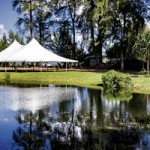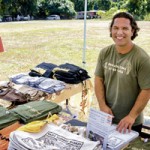Restoring Hawaiian Traditions
Waipa is one of my favorite places on earth. It seems the ancient spirits of Kaua’i collect in the clouds and crevices of the mountains, land and sea, and cling to a new generation of Hawaiians intent on preserving Hawaii’s culture, history and tradition.
From mauka to makai (mountain to sea), the Waipa Foundation, a community-based nonprofit, seeks to restore health and abundance to a 1,600-acre watershed or ahupua’a in Hawaiian.
Ahupua’a is an ancient form of sustainable agriculture that nourished people while preserving the land. Plants, animals and fish were grown in ideal locations, and harvested seasonally. This ensured ocean fish were abundant, and fishponds – located by streams or along the shore – were built so small fish would enter, eat safely and grow too big to leave. Among Pacific Island cultures, fishponds are unique to Hawaii.
The forest provided wild boar, and koa wood for canoes, house posts and religious carvings, and sandalwood trees were used for scenting clothes – until they went extinct because the monarchy made profits selling the fragrant trees to China. Sugarcane, yams and sweet potatoes grew in the moist, upcountry soil. Dryland taro flourished in coastal plains and valleys, along with ti, the leaves of which are used to wrap food. Lo’i, ponds for wetland taro, were built near the kahawai, or “the place having fresh water.” Coconut palms and pandanus trees thrived near the shore.
At Waipa, these traditions are being resurrected. The seven-acre Halulu Fishpond has just been restored. Although the Waioli Stream runs nearby and Hanalei Bay is close, this fishpond has an underground water source.
“This one is unique,” says Kalen Kelekoma, site and program manager for the Waipa Foundation. “It’s separated from the ocean and stream by sand, so it’s naturally made.” The fishpond is stocked with Hawaiian fish and contains floating islands, providing protection from larger predatory fish.
On Dec. 1, a grassy swath of land near Halulu Fishpond will be the site for this year’s Kalo Festival. The event includes food, educational displays, hands-on keiki activities, unique Kaua’i artisans, and contests for the best kalo recipe and biggest kalo.
More than 2,000 trees and shrubs have been planted at Waipa, including 1,000 native koa trees. Most of the seeds for the out-planting were collected in and around Waipa. Kalo is grown on 10 acres using the same water system as hundreds of generations before. The Waipa Garden grows vegetables for the Waipa Farmers Market, held every Tuesday from 2 to 5 p.m.
“The market has been going on for 20 years,” says Kelekoma. “We have 30 vendors, most of whom are farmers, but we also have value-added products and artisans.”
Recently, the farmers market was relocated so construction could begin on the community center.
“A multipurpose building and landscaping are being worked on now,” says Kelekoma. “Once that is done, we’ll start on a certified community kitchen, poi mill and a hale imu.”
It’s Election Day when I visit. The keiki have the day off from school and
have joined the Waipa ohana. As lunch is served, the kids zip around laughing and playing, despite having just climbed a nearby mountain top.
For more information, visit WaipaFoundation.org.
Marta Lane is a Kaua’i-based food writer. For more information, visit TastingKauai.com.
- Carmen Durney of Wai‘iti Soap and Botanicals
- Halulu Fishpond, the site of the 2012 Kalo Festival
- Kalen Kelekoma at the Waipa Farmers Market. Daniel Lane photos
- At the Waipa Farmers Market Hawaiian seed jewelry
- the Waipa Farmers Market is held ongoing Tuesdays from 2 to 5 p.m.
- Janine Celina at the market. Daniel Lane photos









